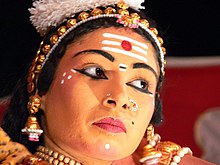Tripundra
A tripundra ( Sanskrit : त्रिपुण्ड्र) is a tilaka ( sign of blessing) that the followers of the Hindu deity Shiva usually wear on their foreheads. It consists of three horizontal lines and usually a bindi . A tripundra is made from vibhuti ( holy ashes ), which are created, for example, during an Agnihotra ritual or by burning cow dung during an offering. The three horizontal lines are , according to one interpretation, a symbol for the trishula , according to another, they stand for the third eye of Shiva.
history
The custom is already mentioned in the Upanishads . According to Paul Deussen , the allegorical meanings of the three ash lines include the three audible syllables of the Aum , the three Gunas or the three appearances of Shiva.
Use and meaning
The tripuṇḍra, three horizontal lines on the forehead or other parts of the body, are symbols that are worn during the rites of passage; for some, wearing it is part of everyday practice. These lines represent Shiva's threefold power of will (icchāśakti), knowing (jñānaśakti) and doing (kriyāśakti). In addition, the trident (triśūla) of Shiva and the Trimurti of Brahma, Vishnu and Shiva are symbolized.
Tripundra is to the bearer, a reminder of the spiritual goals of life, the truth that the body and all material things will one day turn to ashes, and that moksha (enlightenment) is a worthwhile goal. Tri means three, pundra means the one who was set free. There are three horizontal lines of vibhuti , sacred ashes, on the forehead, with a bindi (point) as the third eye. Sacred ashes, usually made from burned cow dung, are a reminder of the ephemeral nature of the physical body and the importance of spiritual enlightenment and closeness to Shiva. Chapter 2 of the Kalagni Rudra Upanishad explains the three lines as different Trimurti: sacred fires , syllables of Om , Guna s, worlds, atmantypes , powers, Vedas, the time to obtain the Vedic drink Soma , and Mahesvara (a form of Shiva).
Regional names
In Tamil , Tripundra is பட்டை / Pattai , or Tripundraka (त्रिपुण्ड्रक).
literature
- Gautam Chatterjee: Sacred Hindu Symbols. 2nd edition. Abhinav Publications, New Delhi 2001, ISBN 81-7017-397-3 , pp. 58 ff .; limited preview in Google Book search
- Klaus K. Klostermaier: Mythologies and Philosophies of Salvation in the Theistic Traditions of India . Wilfrid Laurier Univ. Press, 1984, ISBN 978-0-88920-158-3 , pp. 131,371.
- Paul Deussen: Sixty Upanishads of the Veda . Motilal Banarsidass Publ., 1997, ISBN 978-81-208-1467-7 , pp. 789-790.
Individual evidence
- ^ Edward Balfour (Ed.): Cyclopædia of India and of Eastern and Southern Asia. Volume 5. 2nd Edition. Scottish, Lawrence & Adelphi Presses, Madras 1873, [1] .
- ↑ James G. Lochtefeld: The Illustrated Encyclopedia of Hinduism: NZ . Rosen Publishing Group, New York City 2002, ISBN 0-8239-3180-3 , p. 709
- ↑ त्रिपुण्ड्रक Sanskrit-English dictionary, University of Cologne


